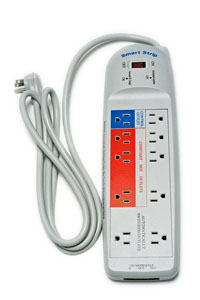|
|
|
Studies have shown that the average computers idle time represents from 69 to 97 percent of its total annual energy use, regardless of whether power management software is utilized. Much of this waste is avoidable since most of us have simply adopted the bad habit of leaving the computer running for hours or even days when we are not even using it. Perhaps we were working on a project and just did not want to go through the saving and shut down process, or we simply forget the computer was running, but regardless of our reasons, our computer, monitor, printer, sound system, external drives, scanners and other peripheral devices sit quietly in the background consuming power, even if we do not use them for days.  "Too much computer energy is wasted. The average computers idle time consumes 69 to 97 percent of its total energy use. There are a few easy steps to fix this and save a lot of money on energy costs." To put things into perspective, I hooked up a Kill-A-Watt metering device in line with the main power that supplies my entire computer system so that I might determine what my system draws while under normal use. My results were:
With this data in mind, and forming a base of normally using the computer system for eight hours a day, let's look at both the typical level of waste of leaving peripheral devices running when not in use and also the extreme level of energy waste by also leaving the computer running when not in use. Typical Example - Having shut down the computer after eight hours of normal use, the remaining components still used 52 watts of power. Since my UPS used 16 watts and needed to stay on, the power wasted by the peripherals in the background was 36 watts. This is almost equivalent to having three 13 watt CFL powered lamps turned on. If a computer system is normally inactive for the remaining 16 hours of the day, the average waste for the year by leaving the peripheral devices running would be 36 watts x 16 hours x 365 days = 210,240 watts per year. We divide this by 1000 to get 210.24 KWH (kilowatt hours). At 14 cents per KWH, a yearly waste of $29.43 would be realized. Extreme Example - If, after using the computer system for the average eight hour period of the day, you failed to shut down the entire computer system half the time, the total wasted power and associated costs would be: 171 total watts - 16 watts used by UPS = 155 wasted watts x 16 hours x 182 days = 451,360 watts. We divide this by 1000 to get a total of 451.4 kilowatt hours wasted by leaving your computer system on half of the time when you should have shut it down. Meanwhile, even when the computer system was turned off, if the peripherals are not shut off as portrayed in the previous example, we add 105 KWH which is in half the total of KWH from the 'typical example' detailed above, for a total of 556.52 wasted KWH. At 14 cents per KWH, a yearly waste of $77.91 would be realized. Bear in mind that these examples are only for one computer and can be multiplied for the number of computers you have in your home. Since we all love using our computers, that power is normally well used, but to waste power with our computers is totally unnecessary and can be fixed by doing two things:
More Ways to Cut Back Computer Energy Costs
( This article is an excerpt from the book 'The Rewards of Making Energy Efficient Choices'. )
David Nelmes Sr. - David is an author and home energy inspector in Pennsylvania, specializing in the fields of Heating and Air Conditioning, Electrical Wiring and Interiors/Insulation. David’s career highlights include authoring 'The Rewards of Making Energy Efficient Choices', working in the electrical engineering division of three nuclear power plants and serving as an administrator, engineer and installer in the heating and air conditioning field. He lives in Northeast Pennsylvania with his wonderful and supportive wife, Karlene and spends his time writing, performing home energy audits and developing web sites. Website: Energy Efficient Choices
This energy related article was reproduced with permission from Alternative Power Choices and is ©2008 David Nelmes. |
|
Review our Privacy Statement